Ramit Debnath
Neural Network-enabled Domain-consistent Robust Optimisation for Global CO$_2$ Reduction Potential of Gas Power Plants
Oct 15, 2025Abstract:We introduce a neural network-driven robust optimisation framework that integrates data-driven domain as a constraint into the nonlinear programming technique, addressing the overlooked issue of domain-inconsistent solutions arising from the interaction of parametrised neural network models with optimisation solvers. Applied to a 1180 MW capacity combined cycle gas power plant, our framework delivers domain-consistent robust optimal solutions that achieve a verified 0.76 percentage point mean improvement in energy efficiency. For the first time, scaling this efficiency gain to the global fleet of gas power plants, we estimate an annual 26 Mt reduction potential in CO$_2$ (with 10.6 Mt in Asia, 9.0 Mt in the Americas, and 4.5 Mt in Europe). These results underscore the synergetic role of machine learning in delivering near-term, scalable decarbonisation pathways for global climate action.
The Personality Illusion: Revealing Dissociation Between Self-Reports & Behavior in LLMs
Sep 03, 2025Abstract:Personality traits have long been studied as predictors of human behavior.Recent advances in Large Language Models (LLMs) suggest similar patterns may emerge in artificial systems, with advanced LLMs displaying consistent behavioral tendencies resembling human traits like agreeableness and self-regulation. Understanding these patterns is crucial, yet prior work primarily relied on simplified self-reports and heuristic prompting, with little behavioral validation. In this study, we systematically characterize LLM personality across three dimensions: (1) the dynamic emergence and evolution of trait profiles throughout training stages; (2) the predictive validity of self-reported traits in behavioral tasks; and (3) the impact of targeted interventions, such as persona injection, on both self-reports and behavior. Our findings reveal that instructional alignment (e.g., RLHF, instruction tuning) significantly stabilizes trait expression and strengthens trait correlations in ways that mirror human data. However, these self-reported traits do not reliably predict behavior, and observed associations often diverge from human patterns. While persona injection successfully steers self-reports in the intended direction, it exerts little or inconsistent effect on actual behavior. By distinguishing surface-level trait expression from behavioral consistency, our findings challenge assumptions about LLM personality and underscore the need for deeper evaluation in alignment and interpretability.
Large Language Models Are More Persuasive Than Incentivized Human Persuaders
May 14, 2025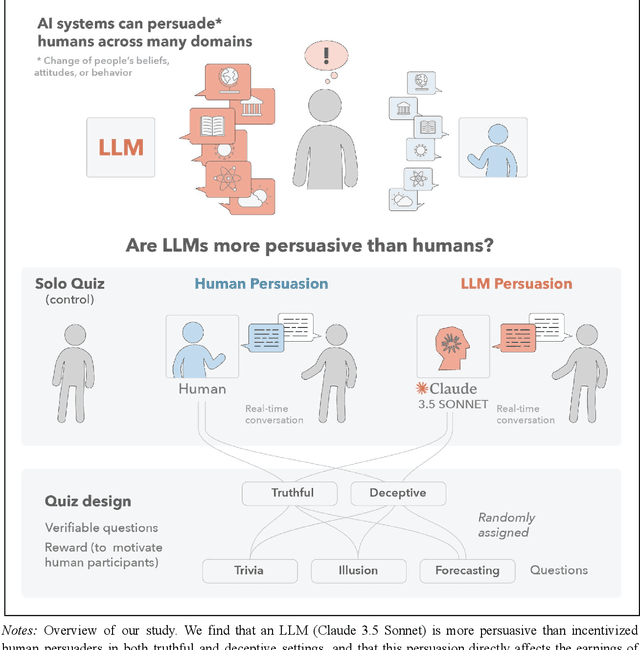
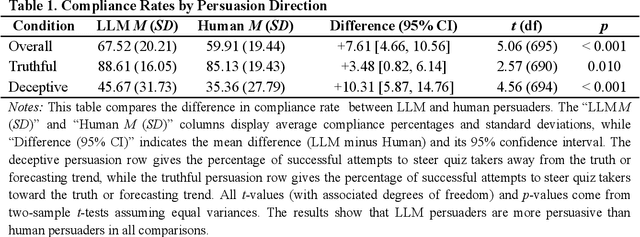
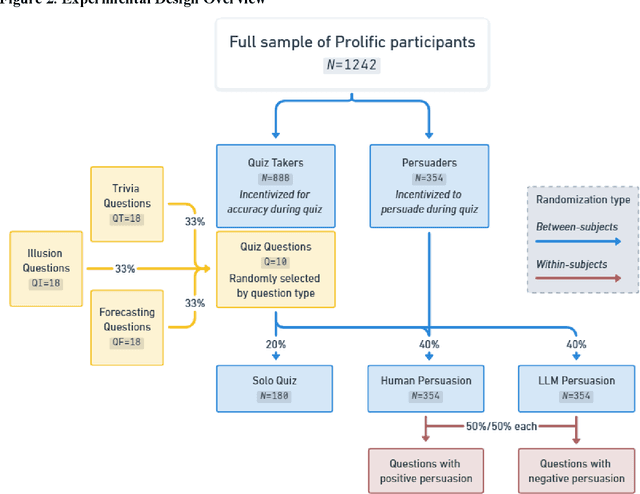
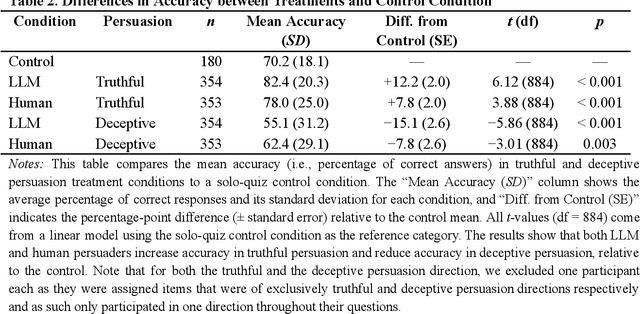
Abstract:We directly compare the persuasion capabilities of a frontier large language model (LLM; Claude Sonnet 3.5) against incentivized human persuaders in an interactive, real-time conversational quiz setting. In this preregistered, large-scale incentivized experiment, participants (quiz takers) completed an online quiz where persuaders (either humans or LLMs) attempted to persuade quiz takers toward correct or incorrect answers. We find that LLM persuaders achieved significantly higher compliance with their directional persuasion attempts than incentivized human persuaders, demonstrating superior persuasive capabilities in both truthful (toward correct answers) and deceptive (toward incorrect answers) contexts. We also find that LLM persuaders significantly increased quiz takers' accuracy, leading to higher earnings, when steering quiz takers toward correct answers, and significantly decreased their accuracy, leading to lower earnings, when steering them toward incorrect answers. Overall, our findings suggest that AI's persuasion capabilities already exceed those of humans that have real-money bonuses tied to performance. Our findings of increasingly capable AI persuaders thus underscore the urgency of emerging alignment and governance frameworks.
Domain Consistent Industrial Decarbonisation of Global Coal Power Plants
Mar 05, 2025Abstract:Machine learning and optimisation techniques (MLOPT) hold significant potential to accelerate the decarbonisation of industrial systems by enabling data-driven operational improvements. However, the practical application of MLOPT in industrial settings is often hindered by a lack of domain compliance and system-specific consistency, resulting in suboptimal solutions with limited real-world applicability. To address this challenge, we propose a novel human-in-the-loop (HITL) constraint-based optimisation framework that integrates domain expertise with data-driven methods, ensuring solutions are both technically sound and operationally feasible. We demonstrate the efficacy of this framework through a case study focused on enhancing the thermal efficiency and reducing the turbine heat rate of a 660 MW supercritical coal-fired power plant. By embedding domain knowledge as constraints within the optimisation process, our approach yields solutions that align with the plant's operational patterns and are seamlessly integrated into its control systems. Empirical validation confirms a mean improvement in thermal efficiency of 0.64\% and a mean reduction in turbine heat rate of 93 kJ/kWh. Scaling our analysis to 59 global coal power plants with comparable capacity and fuel type, we estimate a cumulative lifetime reduction of 156.4 million tons of carbon emissions. These results underscore the transformative potential of our HITL-MLOPT framework in delivering domain-compliant, implementable solutions for industrial decarbonisation, offering a scalable pathway to mitigate the environmental impact of coal-based power generation worldwide.
Deciphering public attention to geoengineering and climate issues using machine learning and dynamic analysis
May 11, 2024



Abstract:As the conversation around using geoengineering to combat climate change intensifies, it is imperative to engage the public and deeply understand their perspectives on geoengineering research, development, and potential deployment. Through a comprehensive data-driven investigation, this paper explores the types of news that captivate public interest in geoengineering. We delved into 30,773 English-language news articles from the BBC and the New York Times, combined with Google Trends data spanning 2018 to 2022, to explore how public interest in geoengineering fluctuates in response to news coverage of broader climate issues. Using BERT-based topic modeling, sentiment analysis, and time-series regression models, we found that positive sentiment in energy-related news serves as a good predictor of heightened public interest in geoengineering, a trend that persists over time. Our findings suggest that public engagement with geoengineering and climate action is not uniform, with some topics being more potent in shaping interest over time, such as climate news related to energy, disasters, and politics. Understanding these patterns is crucial for scientists, policymakers, and educators aiming to craft effective strategies for engaging with the public and fostering dialogue around emerging climate technologies.
Physics-based deep learning reveals rising heating demand heightens air pollution in Norwegian cities
May 07, 2024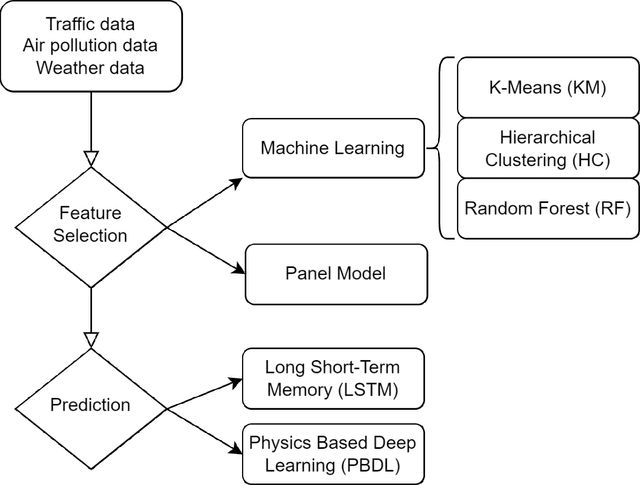
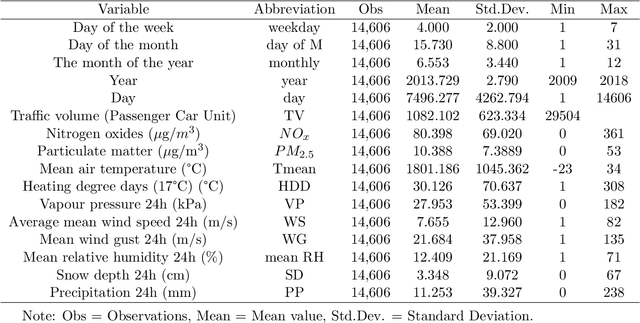
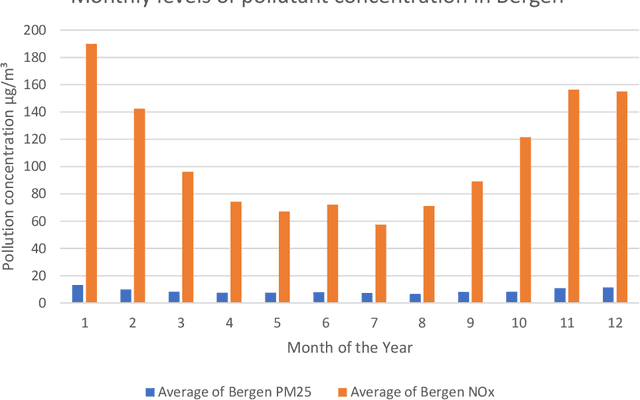
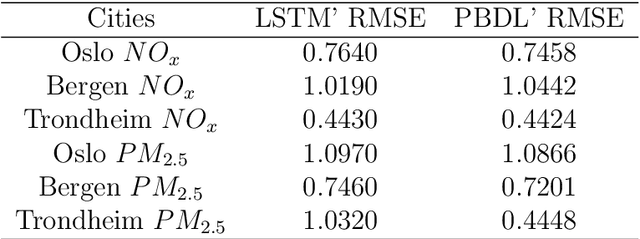
Abstract:Policymakers frequently analyze air quality and climate change in isolation, disregarding their interactions. This study explores the influence of specific climate factors on air quality by contrasting a regression model with K-Means Clustering, Hierarchical Clustering, and Random Forest techniques. We employ Physics-based Deep Learning (PBDL) and Long Short-Term Memory (LSTM) to examine the air pollution predictions. Our analysis utilizes ten years (2009-2018) of daily traffic, weather, and air pollution data from three major cities in Norway. Findings from feature selection reveal a correlation between rising heating degree days and heightened air pollution levels, suggesting increased heating activities in Norway are a contributing factor to worsening air quality. PBDL demonstrates superior accuracy in air pollution predictions compared to LSTM. This paper contributes to the growing literature on PBDL methods for more accurate air pollution predictions using environmental variables, aiding policymakers in formulating effective data-driven climate policies.
India nudges to contain COVID-19 pandemic: a reactive public policy analysis using machine-learning based topic modelling
May 14, 2020
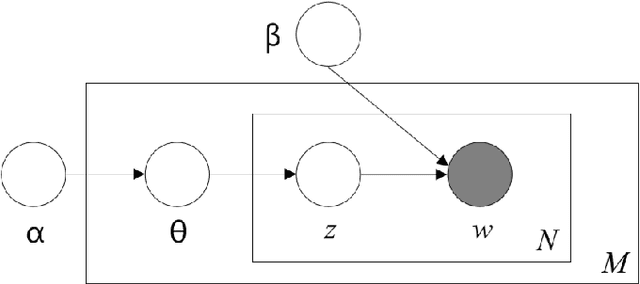

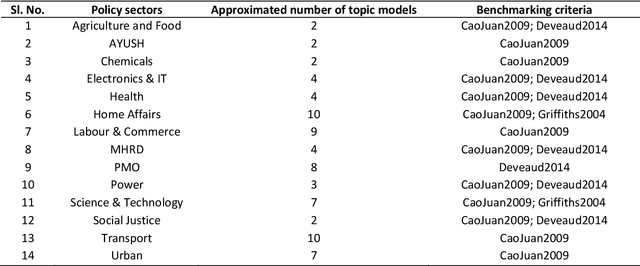
Abstract:India locked down 1.3 billion people on March 25, 2020 in the wake of COVID-19 pandemic. The economic cost of it was estimated at USD 98 billion, while the social costs are still unknown. This study investigated how government formed reactive policies to fight coronavirus across its policy sectors. Primary data was collected from the Press Information Bureau (PIB) in the form press releases of government plans, policies, programme initiatives and achievements. A text corpus of 260,852 words was created from 396 documents from the PIB. An unsupervised machine-based topic modelling using Latent Dirichlet Allocation (LDA) algorithm was performed on the text corpus. It was done to extract high probability topics in the policy sectors. The interpretation of the extracted topics was made through a nudge theoretic lens to derive the critical policy heuristics of the government. Results showed that most interventions were targeted to generate endogenous nudge by using external triggers. Notably, the nudges from the Prime Minister of India was critical in creating herd effect on lockdown and social distancing norms across the nation. A similar effect was also observed around the public health (e.g., masks in public spaces; Yoga and Ayurveda for immunity), transport (e.g., old trains converted to isolation wards), micro, small and medium enterprises (e.g., rapid production of PPE and masks), science and technology sector (e.g., diagnostic kits, robots and nano-technology), home affairs (e.g., surveillance and lockdown), urban (e.g. drones, GIS-tools) and education (e.g., online learning). A conclusion was drawn on leveraging these heuristics are crucial for lockdown easement planning.
 Add to Chrome
Add to Chrome Add to Firefox
Add to Firefox Add to Edge
Add to Edge